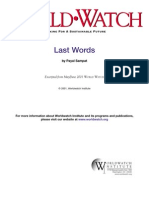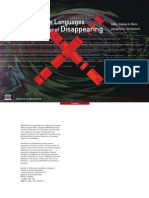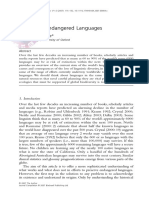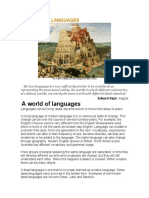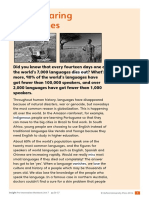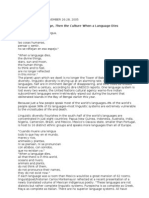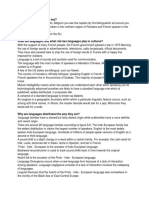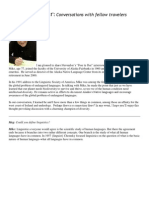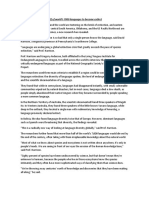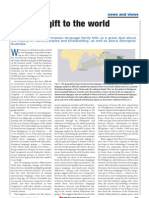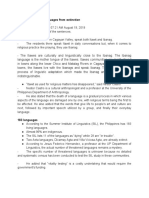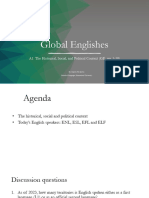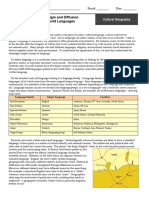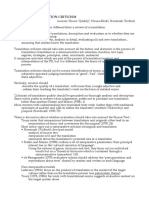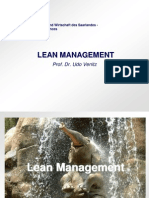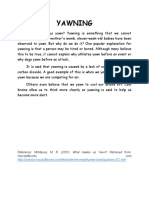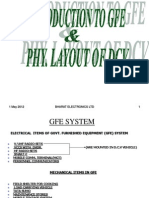The Exodus of Languages PDF
The Exodus of Languages PDF
Uploaded by
rahma alhusnaCopyright:
Available Formats
The Exodus of Languages PDF
The Exodus of Languages PDF
Uploaded by
rahma alhusnaOriginal Title
Copyright
Available Formats
Share this document
Did you find this document useful?
Is this content inappropriate?
Copyright:
Available Formats
The Exodus of Languages PDF
The Exodus of Languages PDF
Uploaded by
rahma alhusnaCopyright:
Available Formats
E R
The Exodus of Languages
The following reading is adapted from the article The Exodus of Languages: How the loss of languages is much like the
loss of a species by Jessica Kwik © 1998. Reprinted from Imprint Online with permission from the author.
"I have made an impression on this first group of Inuit people. My arrival to arctic Canada was a cold
one, but I'm warmed thinking of the events that will someday be stories to tell. The Inuit were surprised to
see my white skin and they told rather humorous jokes about me in Inuktitut.' They stopped laughing
though, when they heard my rebuttal in a dialect of their own tongue. I think I will enjoy this journey from
Greenland to Siberia."
It is doubtful that Knud Rasmussen1 made such a diary entry on his travels, but these events did take place in
the 1920s. Inuit communities throughout arctic Canada understood the Inuktitut spoken by the Greenland-
born Rasmussen. Since the dialects had a common core that could be understood, the diverse dialects show a
common origin, or the same mother language. This divergence of language contrasts with the converging of
languages today that is endangering languages worldwide.
Languages seem to be converging to a smaller number, as languages like English seem to eat up regional
ones. The three languages used the most by first language speakers today are Mandarin Chinese, English,
and Spanish. English is being used more and more as the main language for business, science, and popular
culture. Evidence suggests that the dominant languages are squeezing out the local tongues of various
regions in the world. Linguists estimate that of the approximately 6,500 languages worldwide, about half are
endangered or on the brink of extinction. According to some linguists, the estimated rate of language
extinction is one lost in the world every two weeks. If this sounds like the world is losing a species, in a way
it is.
When a language is lost, meaning no living person can teach another, a world perspective is lost. Some
foreign language expressions simply cannot be translated. Colloquial phrases are pleasant to the ear, not only
because they are familiar, but also because they reflect a unique aspect of a culture. Aboriginal languages in
Canada and other countries such as Australia have words that reflect a way of life that is connected closely to
the Earth. There are fifty different words that mean 'snow' in one Canadian native language, and in the
Eastern Arrernte language of Central Australia the word nyimpe translates to 'the smell of rain.'
These various views of the world are essential for science to help create new ways of understanding and new
connections between the human and the natural world. Botanists have discovered new species of plants by
digging deeper into the meaning of Aboriginal names of flora that seemed identical. Archaeologists are also
using languages to track migrations of historical cultures. University of Waterloo Professor Robert Park
knows that the ancestral origins of the present Canadian Inuit communities can be partly explained by the
language spoken by the Inuit today. The Thule culture spoke the same Inuktitut of present-day Inuit to a
greater or lesser degree. Dr. Park knows the prehistoric Thule migrated east from Alaska and eventually to
Labrador and Greenland by the evidence of the mutually intelligible, living dialects of today.
Languages are much like living creatures that become endangered when numbers dwindle. Local natural
disasters, war, and famine are some of the reasons languages slip through the cracks of history. The
language that bore the different daughter languages for the Eskimo and Inuit was almost wiped out after
World War II. The mother language, Proto-Eskimo Aleut, was under siege when the Aleut people were
forced to leave their land. Fortunately, some Proto-Eskimo Aleut, which originated 6,000 to 8,000 years ago,
is still spoken. Languages also so become endangered when they are not passed on to children or when a
metropolitan language dominates over others.
ENGLISH FOR ACADEMIC PURPOSES 231
E R
Some groups are taking action in preserving languages. Revival of languages such as Irish is gaining ground.
There is an Irish-language television channel and the largest age group of fluent Irish speakers is now the
under-twenty-fives. International organizations are mobilizing for the cause as well: UNESCO has mapped
the Atlas of the World's Languages in Danger of Disappearing in 1996. The editor of the atlas believes the
preservation of moribund languages, which are spoken only by the elderly, should be a priority since they are
on the brink of extinction.
Preservation can occur in two ways. First, linguists can study moribund languages and seek to preserve the
components of the language: the sounds, the vocabulary, the grammar, and the traditions. The second way is
to teach children the language and have linguists advise on language maintenance. An example of this latter
method is the Maori language of New Zealand. It has seen a resurgence in the number of speakers from the
1960s and 1970s when there was virtually no parent to child transmission. New Zealand has since set up
'language nests' in early childhood centers to teach children Maori, exposing 100,000 children to their native
tongue so far.
For many linguists, preserving endangered languages is vital; a loss in global languages means a loss of the
diverse ideas and cultures those languages once held.
----------------
1
Knud Rasmussen: A Danish explorer and ethnologist who extensively researched Inuit culture.
232 ENGLISH FOR ACADEMIC PURPOSES
You might also like
- The Last Speakers: The Quest to Save the World's Most Endangered LanguagesFrom EverandThe Last Speakers: The Quest to Save the World's Most Endangered LanguagesRating: 4.5 out of 5 stars4.5/5 (4)
- The History of The English Language PDFDocument8 pagesThe History of The English Language PDFHolbelMéndez100% (4)
- The Dying of LanguagesDocument8 pagesThe Dying of LanguagesDaisyNo ratings yet
- On The Philippines Linguistic DiversityDocument4 pagesOn The Philippines Linguistic DiversityBrandon FlynNo ratings yet
- Unesco - Atlas of The Worlds Languages in Danger of DisappearingDocument71 pagesUnesco - Atlas of The Worlds Languages in Danger of DisappearingJosé Oliveira JuniorNo ratings yet
- Groups and Teamwork: Chapter 6, Nancy Langton and Stephen P. Robbins, Organizational Behaviour, Fourth Canadian EditionDocument55 pagesGroups and Teamwork: Chapter 6, Nancy Langton and Stephen P. Robbins, Organizational Behaviour, Fourth Canadian EditionKushaal SarafNo ratings yet
- The Exodus of LanguagesDocument2 pagesThe Exodus of Languagescicak merayapNo ratings yet
- Last Living Speakers of Dying LgsDocument2 pagesLast Living Speakers of Dying LgsMarius CristianNo ratings yet
- Speaking With A Single Tongue (Diamond)Document8 pagesSpeaking With A Single Tongue (Diamond)Mark MirandoNo ratings yet
- Disappearing Languages by Rosemarie OstlerDocument4 pagesDisappearing Languages by Rosemarie OstlerUnnati Shah100% (1)
- Language and Linguist Compass - 2007 - Romaine - Preserving Endangered LanguagesDocument18 pagesLanguage and Linguist Compass - 2007 - Romaine - Preserving Endangered LanguagesConstanza MuñozNo ratings yet
- Polina Polyakova, 8"O" 2 Oct, 2019Document12 pagesPolina Polyakova, 8"O" 2 Oct, 2019НадеждаNo ratings yet
- A Mosaic of LanguagesDocument3 pagesA Mosaic of LanguageszoeNo ratings yet
- Crystal, D. Talk for Lingua Franca 2000Document4 pagesCrystal, D. Talk for Lingua Franca 2000vicNo ratings yet
- Dorais 2Document16 pagesDorais 2miindsurferNo ratings yet
- Basque LanguageDocument12 pagesBasque LanguageКирилюк ГеоргийNo ratings yet
- Saving Dying LanguageDocument3 pagesSaving Dying LanguageOlga MagneevaNo ratings yet
- Disappearing Languages: © Oxford University Press 20 4 Pre-Intermediate Workbook Unit pp.56-57Document2 pagesDisappearing Languages: © Oxford University Press 20 4 Pre-Intermediate Workbook Unit pp.56-57Mahammad AliNo ratings yet
- A Mosaic of LanguagesDocument3 pagesA Mosaic of LanguageszoeNo ratings yet
- Saving LanguagesDocument3 pagesSaving LanguagesMichael SmithNo ratings yet
- Local Languages Are Dying Out and Taking Invaluable Knowledge With ThemDocument3 pagesLocal Languages Are Dying Out and Taking Invaluable Knowledge With Themjasleenkaurpandher19No ratings yet
- From Magic Words to Automated Translation: A History of the Inuit LanguageFrom EverandFrom Magic Words to Automated Translation: A History of the Inuit LanguageNo ratings yet
- First Kill The Language, Then The Culture When A Language Dies John RossDocument4 pagesFirst Kill The Language, Then The Culture When A Language Dies John Rossmahiyagi100% (1)
- PART 2 - PicDocument1 pagePART 2 - Picnguyenvanson123qbhNo ratings yet
- On The Philippines' Diversity of Languages: More StoriesDocument4 pagesOn The Philippines' Diversity of Languages: More StoriesJanice KimayongNo ratings yet
- Farah's AssignmentDocument4 pagesFarah's AssignmentAnfal AnfalNo ratings yet
- Immediate Download Australia S Original Languages An Introduction R. M. W. Dixon Ebooks 2024Document52 pagesImmediate Download Australia S Original Languages An Introduction R. M. W. Dixon Ebooks 2024okatsuderoux100% (2)
- Guugu Yimidhirr Language and Their CultureDocument12 pagesGuugu Yimidhirr Language and Their Cultureteachwellbeing9No ratings yet
- Paper English 5 lenguages (1)Document5 pagesPaper English 5 lenguages (1)Daniel AusejoNo ratings yet
- Sociolinguistics - LANGUAGE DEATH Group 6Document4 pagesSociolinguistics - LANGUAGE DEATH Group 6Puji100% (1)
- HuGap Chapter 6Document2 pagesHuGap Chapter 6William AshleyNo ratings yet
- Ernst Håkon Jahr: University of TromsøDocument10 pagesErnst Håkon Jahr: University of Tromsøgoran trajkovskiNo ratings yet
- Whos Afraid of Language DeathDocument20 pagesWhos Afraid of Language Deathminyoongi9870No ratings yet
- Architecture Facuilty: Academic Professional School of ArchitectureDocument8 pagesArchitecture Facuilty: Academic Professional School of ArchitectureJuan Carlos Valdera YslaNo ratings yet
- Annualreviewpaper 3Document53 pagesAnnualreviewpaper 3X AKL 4 Ahmad alvi AfriantoNo ratings yet
- Peer To Pier Conversations With Fellow TravelersDocument12 pagesPeer To Pier Conversations With Fellow TravelersDu Ho DucNo ratings yet
- About The Endangered Languages ProjectDocument2 pagesAbout The Endangered Languages ProjectStela BranisteNo ratings yet
- Half of WorldDocument2 pagesHalf of WorldmnigrinisNo ratings yet
- Canadian Inuit DoraisDocument105 pagesCanadian Inuit Doraisnikolakr8526100% (1)
- Native American Language - PrintDocument4 pagesNative American Language - PrintNita YuitaNo ratings yet
- Jared Diamond - Taiwan's Gift To The WorldDocument2 pagesJared Diamond - Taiwan's Gift To The WorldJojo Malig100% (1)
- Almirante Isac ChinolaneDocument14 pagesAlmirante Isac ChinolaneElito YayaNo ratings yet
- Hard WordsDocument3 pagesHard WordsMarta Toma100% (1)
- Saving PH Diverse Languages From ExtinctionDocument5 pagesSaving PH Diverse Languages From ExtinctionAngelica CruzNo ratings yet
- EndangeredDocument17 pagesEndangeredJuan Andres Narvaez CastañedaNo ratings yet
- Global Englishes: A1. The Historical, Social, and Political Context (GE, Pp. 1-10)Document62 pagesGlobal Englishes: A1. The Historical, Social, and Political Context (GE, Pp. 1-10)Sơn Khanh LyNo ratings yet
- Chapter Six Outline AP Human GeographyDocument10 pagesChapter Six Outline AP Human GeographyReem Abraham67% (3)
- Kiswahili People Language Literature and Lingua FRDocument21 pagesKiswahili People Language Literature and Lingua FRelsiciidNo ratings yet
- U CH ResearchDocument11 pagesU CH ResearchdeniseyarnoldNo ratings yet
- Lecture 5 - Language DeathDocument16 pagesLecture 5 - Language DeathGrace JeffreyNo ratings yet
- The English Language: Learning, Working, and Making a Life in the World's Greatest LanguageFrom EverandThe English Language: Learning, Working, and Making a Life in the World's Greatest LanguageNo ratings yet
- Ethnicity, Tribe, Dialect, Language, Caste and Religion.Document5 pagesEthnicity, Tribe, Dialect, Language, Caste and Religion.madarauchiha9tails11No ratings yet
- Yuchi: An Endangered Language in The Heart of Southeastern USADocument10 pagesYuchi: An Endangered Language in The Heart of Southeastern USAcmj00028No ratings yet
- Languagesoftheworld OREDocument27 pagesLanguagesoftheworld OREojasbear5No ratings yet
- LH 2 - 1 Indo-EuropeanDocument7 pagesLH 2 - 1 Indo-EuropeanCarmen FloresNo ratings yet
- Ap Hug Outline Ch. 5Document3 pagesAp Hug Outline Ch. 5mahuli124No ratings yet
- Garrett - New Perspectives On Indo-European Phylogeny and Chronology (2018)Document14 pagesGarrett - New Perspectives On Indo-European Phylogeny and Chronology (2018)lingenberriesNo ratings yet
- Humboldt and The World of LanguagesDocument20 pagesHumboldt and The World of LanguagesSthefany RosaNo ratings yet
- The Problem - Language DeathDocument3 pagesThe Problem - Language DeathAsim MahatoNo ratings yet
- KapculDocument8 pagesKapculCharina Sunido GuarinoNo ratings yet
- Corporate Logo ManualDocument16 pagesCorporate Logo ManualDianne MercadoNo ratings yet
- hsk3 Exam h31330Document18 pageshsk3 Exam h31330Eva DongNo ratings yet
- Missionaries and Cannibals Python AiDocument3 pagesMissionaries and Cannibals Python Ai21131A4433 MUTHA RESHMIKANo ratings yet
- 11 Normal DistributionDocument19 pages11 Normal DistributionA.B. Cbm50% (2)
- A Rope of Mass 0.65 KG Is Stretched Between Two Supports 30 M Apart. If The Tension in The Rope Is 120 N, How Long Will It Take A Pulse To Travel From One Support To The Other?Document6 pagesA Rope of Mass 0.65 KG Is Stretched Between Two Supports 30 M Apart. If The Tension in The Rope Is 120 N, How Long Will It Take A Pulse To Travel From One Support To The Other?peyying12No ratings yet
- Philosophical Chairs ReflectionDocument3 pagesPhilosophical Chairs ReflectionKendria ByrdNo ratings yet
- Phy150 - Chapter 1 Electric Charge & Electric Field 2018Document107 pagesPhy150 - Chapter 1 Electric Charge & Electric Field 2018Nurul AtikaNo ratings yet
- CS3235 SemI 2017 18 FinalProjectsDocument104 pagesCS3235 SemI 2017 18 FinalProjectsJulius Putra Tanu SetiajiNo ratings yet
- Project Management Knowledge Acronyms and AbbreviationsDocument14 pagesProject Management Knowledge Acronyms and AbbreviationsgetkhosaNo ratings yet
- Notes On Translation Criticism PDFDocument5 pagesNotes On Translation Criticism PDFkovinusNo ratings yet
- Training: Willie Smits (Born February 22, 1957, inDocument6 pagesTraining: Willie Smits (Born February 22, 1957, inMutiara AzizNo ratings yet
- Migration: Causes and EffectsDocument5 pagesMigration: Causes and EffectsFarukh KhanNo ratings yet
- ESRI - ArcGISDocument7 pagesESRI - ArcGISDuong NgoNo ratings yet
- Lean ManagementDocument28 pagesLean Managementmarbtec111550% (2)
- Columbian Exchange Lesson PlanDocument4 pagesColumbian Exchange Lesson Planapi-283709630No ratings yet
- Meditation, Restoration, and The Management of Mental FatigueDocument27 pagesMeditation, Restoration, and The Management of Mental FatigueBetzi RuizNo ratings yet
- Teaching Music To Autistic ChildrenDocument4 pagesTeaching Music To Autistic ChildrenBárbara de SouzaNo ratings yet
- GST Grade 6-YAWNINGDocument3 pagesGST Grade 6-YAWNINGFrance Xavier Solite Villagonzalo100% (1)
- Situational Language TeachingDocument2 pagesSituational Language TeachingSylvaen WswNo ratings yet
- Magic of ChemistryDocument8 pagesMagic of ChemistryWaDikunNo ratings yet
- Avamar Frequently Asked Questions: Q. I Recently Deleted A Lot of Backups. How Do I Tell How Much Space I Will Get Back?Document2 pagesAvamar Frequently Asked Questions: Q. I Recently Deleted A Lot of Backups. How Do I Tell How Much Space I Will Get Back?Nithya RaviNo ratings yet
- GFEDocument56 pagesGFENishikant SharmaNo ratings yet
- ITPO Approved FairsDocument2 pagesITPO Approved Fairsnickslam007No ratings yet
- Ukuran Asosiasi Dalam Epidemiologi: Putri Handayani, M. KKKDocument28 pagesUkuran Asosiasi Dalam Epidemiologi: Putri Handayani, M. KKKNHLNo ratings yet
- Statistically Derived Rate-of-Change Oil Analysis Limits and AlarmsDocument4 pagesStatistically Derived Rate-of-Change Oil Analysis Limits and Alarmsgilar herliana putraNo ratings yet
- Aci 347-04Document9 pagesAci 347-04John Rhey Almojallas BenedictoNo ratings yet
- Black Swan Transcript 14Document3 pagesBlack Swan Transcript 14Michele RyanNo ratings yet
- R01 - Aronson 1959 - The Effect of Severity of Initiation On Liking For A GroupDocument3 pagesR01 - Aronson 1959 - The Effect of Severity of Initiation On Liking For A GroupGrupa5No ratings yet
- Communicate With Power Teleseminar Notes PDFDocument9 pagesCommunicate With Power Teleseminar Notes PDFTouati Bilal100% (1)


